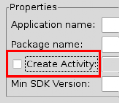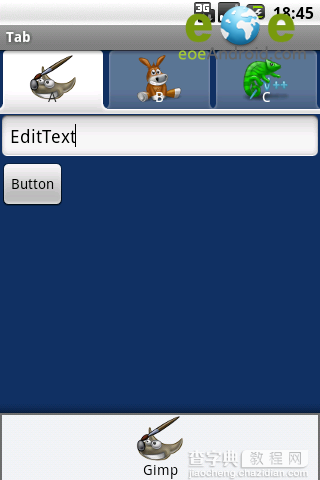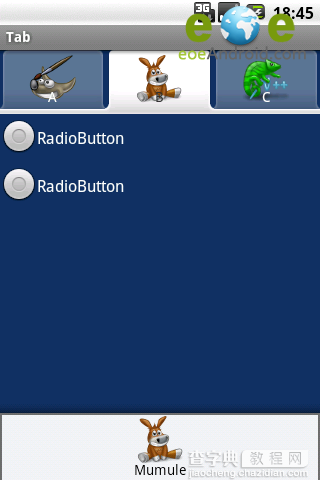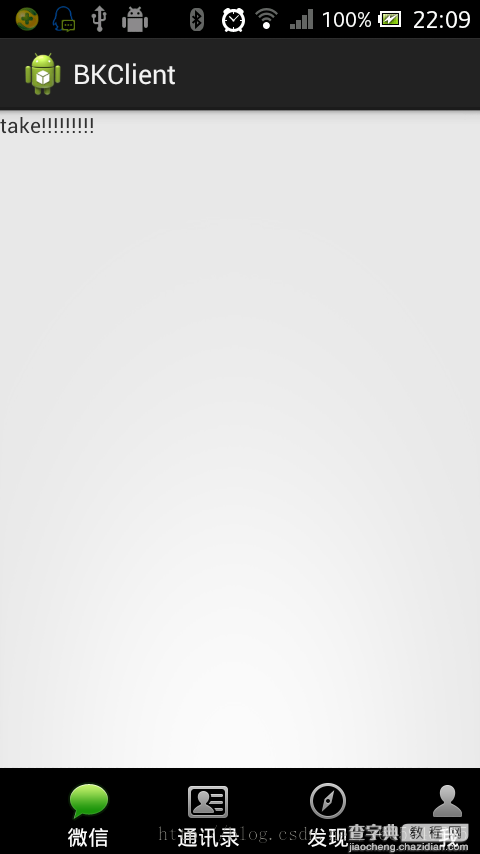Tab与TabHost:

这就是Tab,而盛放Tab的容器就是TabHost 。
如何实现??
每一个Tab还对应了一个布局,这个就有点好玩了。一个Activity,对应了多个功能布局。
新建一个Tab项目,注意,不要生成main Activity 。

注意IDE,这里不要选...
在包里面新建一个类MyTab,继承于TabActivity。
其实,TabActivity是Activity的子类
package zyf.tab.test; import android.app.TabActivity; public class MyTab extends TabActivity { }
从父类继承OnCreate()入口方法
package zyf.tab.test; import android.app.TabActivity; import android.os.Bundle; public class MyTab extends TabActivity { @Override protected void onCreate(Bundle savedInstanceState) { // TODO Auto-generated method stub super.onCreate(savedInstanceState); } }
在Manifest.xml文件中注册一下MyTab类(Activity)
<activity android:name=".MyTab"> <intent-filter> <action android:name="android.intent.action.MAIN"></action> <category android:name="android.intent.category.LAUNCHER"></category> </intent-filter> </activity>
这时候,需要设计一下标签页对应的布局,一般采用FrameLayout作为根布局,每个标签页面对应一个子节点的Layout
<"1.0" encoding="utf-8"?> < > <FrameLayout xmlns:android="http://schemas.android.com/apk/res/android" android:layout_width="fill_parent" android:layout_height="fill_parent"> < > <LinearLayout android:id="@+id/widget_layout_Blue" android:layout_width="fill_parent" android:layout_height="fill_parent" androidrientation="vertical" > <EditText android:id="@+id/widget34" android:layout_width="fill_parent" android:layout_height="wrap_content" android:text="EditText" android:textSize="18sp"> </EditText> <Button android:id="@+id/widget30" android:layout_width="wrap_content" android:layout_height="wrap_content" android:text="Button"> </Button> </LinearLayout> < > <LinearLayout android:id="@+id/widget_layout_red" android:layout_width="fill_parent" android:layout_height="fill_parent" androidrientation="vertical" > <AnalogClock android:id="@+id/widget36" android:layout_width="wrap_content" android:layout_height="wrap_content"> </AnalogClock> </LinearLayout> < > <LinearLayout android:id="@+id/widget_layout_green" android:layout_width="fill_parent" android:layout_height="fill_parent" androidrientation="vertical"> <RadioGroup android:id="@+id/widget43" android:layout_width="166px" android:layout_height="98px" androidrientation="vertical"> <RadioButton android:id="@+id/widget44" android:layout_width="wrap_content" android:layout_height="wrap_content" android:text="RadioButton"> </RadioButton> <RadioButton android:id="@+id/widget45" android:layout_width="wrap_content" android:layout_height="wrap_content" android:text="RadioButton"> </RadioButton> </RadioGroup> </LinearLayout> </FrameLayout>
首先,应该声明TabHost,然后用LayoutInflater过滤出布局来,给TabHost加上含有Tab页面的FrameLayout
private TabHost myTabhost; myTabhost=this.getTabHost();//从TabActivity上面获取放置Tab的TabHost LayoutInflater.from(this).inflate(R.layout.main, myTabhost.getTabContentView(), true); //from(this)从这个TabActivity获取LayoutInflater //R.layout.main 存放Tab布局 //通过TabHost获得存放Tab标签页内容的FrameLayout //是否将inflate 拴系到根布局元素上 myTabhost.setBackgroundColor(Color.argb(150, 22, 70, 150)); //设置一下TabHost的颜色
接着,在TabHost创建一个标签,然后设置一下标题/图标/标签页布局
myTabhost.addTab(myTabhost.newTabSpec("TT")// 制造一个新的标签TT .setIndicator("KK",getResources().getDrawable(R.drawable.ajjc)) // 设置一下显示的标题为KK,设置一下标签图标为ajjc .setContent(R.id.widget_layout_red)); //设置一下该标签页的布局内容为R.id.widget_layout_red,这是FrameLayout中的一个子Layout
标签切换事件处理,setOnTabChangedListener
myTabhost.setOnTabChangedListener(new OnTabChangeListener(){ @Override public void onTabChanged(String tabId) { // TODO Auto-generated method stub } });
各个标签页的动态MENU
先把在XML中设计好的MENU放到一个int数组里
private static final int myMenuResources[] = { R.menu.phonebook_menu, R.menu.addphone_menu, R.menu.chatting_menu, R.menu.userapp_menu };
在setOnTabChangedListener()方法中根据标签的切换情况来设置myMenuSettingTag
Override public void onTabChanged(String tagString) { // TODO Auto-generated method stub if (tagString.equals("One")) { myMenuSettingTag = 1; } if (tagString.equals("Two")) { myMenuSettingTag = 2; } if (tagString.equals("Three")) { myMenuSettingTag = 3; } if (tagString.equals("Four")) { myMenuSettingTag = 4; } if (myMenu != null) { onCreateOptionsMenu(myMenu); } }
然后onCreateOptionsMenu(Menu menu) 方法中通过MenuInflater过滤器动态加入MENU
@Override public boolean onCreateOptionsMenu(Menu menu) { // TODO Auto-generated method stub // Hold on to this myMenu = menu; myMenu.clear();//清空MENU菜单 // Inflate the currently selected menu XML resource. MenuInflater inflater = getMenuInflater(); //从TabActivity这里获取一个MENU过滤器 switch (myMenuSettingTag) { case 1: inflater.inflate(myMenuResources[0], menu); //动态加入数组中对应的XML MENU菜单 break; case 2: inflater.inflate(myMenuResources[1], menu); break; case 3: inflater.inflate(myMenuResources[2], menu); break; case 4: inflater.inflate(myMenuResources[3], menu); break; default: break; } return super.onCreateOptionsMenu(menu); }
menu 布局
<"1.0" encoding="utf-8"?> <menu xmlns:android="http://schemas.android.com/apk/res/android"> <group android:id="@+id/group_a"><item android:id="@+id/item_a" android:icon="@drawable/gimp" android:title="Gimp"></item> </group> </menu>
运行效果



模仿微信导航实例:

<"1.0" encoding="utf-8"?> <TabHost xmlns:android="http://schemas.android.com/apk/res/android" android:id="@android:id/tabhost" android:layout_width="match_parent" android:layout_height="match_parent" > <LinearLayout android:layout_width="match_parent" android:layout_height="match_parent" android:orientation="vertical" > <FrameLayout android:id="@android:id/tabcontent" android:layout_width="match_parent" android:layout_height="0.0dip" android:layout_weight="1.0" > </FrameLayout> <TabWidget android:id="@android:id/tabs" android:layout_width="match_parent" android:layout_height="wrap_content" android:visibility="gone" > </TabWidget> <RadioGroup android:layout_width="match_parent" android:layout_height="wrap_content" android:layout_gravity="bottom" android:background="@android:color/black" android:orientation="horizontal" > <RadioButton android:id="@+id/talk" android:drawableTop="@drawable/take_bottom" android:text="@string/talk" /> <RadioButton android:id="@+id/address" android:drawableTop="@drawable/adrress_bottom" android:text="@string/address" /> <RadioButton android:id="@+id/find" android:drawableTop="@drawable/find_bottom" android:text="@string/find" /> <RadioButton android:id="@+id/me" android:drawableTop="@drawable/me_bottom" android:text="@string/me" /> </RadioGroup> </LinearLayout> </TabHost>
<"1.0" encoding="utf-8"?> <selector xmlns:android="http://schemas.android.com/apk/res/android"> <item android:drawable="@drawable/n_address_l" android:state_checked="true" android:state_enabled="true"/> <item android:drawable="@drawable/n_address_h"/> </selector>
package com.android.xiong.bkclient; import android.app.TabActivity; import android.content.Intent; import android.os.Bundle; import android.widget.CompoundButton; import android.widget.CompoundButton.OnCheckedChangeListener; import android.widget.RadioButton; import android.widget.TabHost; @SuppressWarnings("deprecation") public class MainActivity extends TabActivity implements OnCheckedChangeListener { private TabHost tabHost; private Intent addressIntent; private Intent meIntent; private Intent takeIntent; private Intent findIntent; private RadioButton findBt; private RadioButton addressBt; private RadioButton meBt; private RadioButton takeBt; @Override protected void onCreate(Bundle savedInstanceState) { super.onCreate(savedInstanceState); setContentView(R.layout.tabhostmain); addressIntent = new Intent(this, AddressActivity.class); meIntent = new Intent(this, MeActivity.class); takeIntent = new Intent(this, TakeActivity.class); findIntent = new Intent(this, FindActivity.class); findBt = (RadioButton) findViewById(R.id.find); addressBt = (RadioButton) findViewById(R.id.address); meBt = (RadioButton) findViewById(R.id.me); takeBt = (RadioButton) findViewById(R.id.talk); tabHost =getTabHost(); tabHost.addTab(tabHost.newTabSpec("take").setIndicator("take") .setContent(takeIntent)); tabHost.addTab(tabHost.newTabSpec("address").setIndicator("address") .setContent(addressIntent)); tabHost.addTab(tabHost.newTabSpec("find").setIndicator("find") .setContent(findIntent)); tabHost.addTab(tabHost.newTabSpec("me").setIndicator("me") .setContent(meIntent)); findBt.setOnCheckedChangeListener(this); meBt.setOnCheckedChangeListener(this); takeBt.setOnCheckedChangeListener(this); addressBt.setOnCheckedChangeListener(this); } @Override public void onCheckedChanged(CompoundButton view, boolean ischeak) { if (ischeak) { switch (view.getId()) { case R.id.talk: tabHost.setCurrentTabByTag("take"); break; case R.id.find: tabHost.setCurrentTabByTag("find"); break; case R.id.me: tabHost.setCurrentTabByTag("me"); break; case R.id.address: tabHost.setCurrentTabByTag("address"); break; default: break; } } } }
<manifest xmlns:android="http://schemas.android.com/apk/res/android" package="com.android.xiong.bkclient" android:versionCode="1" android:versionName="1.0" > <uses-sdk android:minSdkVersion="8" android:targetSdkVersion="19" /> <application android:allowBackup="true" android:icon="@drawable/ic_launcher" android:label="@string/app_name" android:theme="@style/AppTheme" > <activity android:name="com.android.xiong.bkclient.MainActivity"> <intent-filter> <action android:name="android.intent.action.MAIN" /> <category android:name="android.intent.category.LAUNCHER" /> </intent-filter> </activity> <activity android:name="com.android.xiong.bkclient.AddressActivity"></activity> <activity android:name="com.android.xiong.bkclient.FindActivity"></activity> <activity android:name="com.android.xiong.bkclient.MeActivity"></activity> <activity android:name="com.android.xiong.bkclient.TakeActivity"></activity> </application> </manifest>


